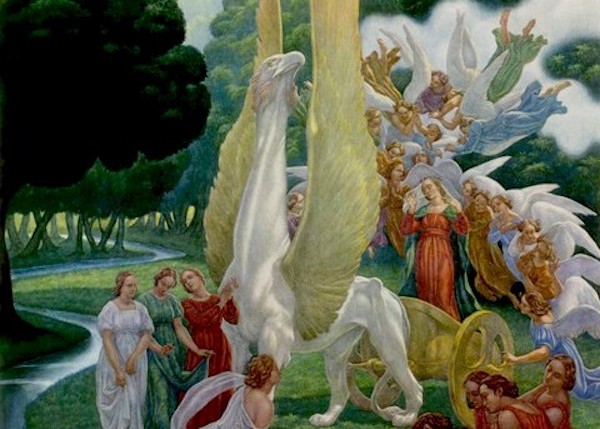After the crossing of the river Lethe and the cleansing of old misconceptions, the spiritual vision of the Pilgrim is much clearer and more intense.
The very first thing that happens is that Dante redeems his old guiding stars from pagan virtue as handmaidens for the spiritual life. They are now framed as leading humanity to the emergence of the spiritual revelation, with the soul as a portal to the Divine.
They then bring him directly to Beatrice, but with several important details: they point out the three spiritual/theological virtues (Faith, Hope and Love of Being), and then put the pilgrim in front of the breast of the griffin, where Beatrice is now directing her gaze and focus.
The geometry here is essential. Rather than merely taking him to the chariot, Dante sets up a much deeper insight. Beatrice is here his inner spiritual life directing its focus on the unity of the griffin, as the material and spiritual, and also as a symbol of Christ. This is the force that pulls the soul towards greater understanding of the Heavens and of the world. And the breast is important – as the heart. Combining the Intellect/Wisdom and the Love/Spiritual is the dynamic the grows and elevates the soul.
So the pilgrim is now being attentive to both his soul (directed at God/Christ), and God/Christ directly.
His eyes are drawn to Beatrice’s eyes, in a way intensifying his focus on his inner soul. And what he then sees, radiating deep within his soul, is the reflection of the griffin like the sun in a mirror (in lo specchio il sol), now with the material, now with the spiritual aspects.
And then comes the revolutionary insight: as the pilgrim is looking at both the griffin and the reflection of it in Beatrice’s eyes, he notices that the real griffin in front of him is stable, but the image and reflection of it within his soul, is transforming. Thus we have a new overall image for the journey: a way of visualizing both God, and our perception of God within our Soul simultaneously, the latter growing and changing.
This becomes the vehicle (or “carro”) that sets up the whole of Paradiso. To understand and visualize how the soul can now keep reflecting and growing in Divine Wisdom, which itself is eternal, stable and unchanging. This becomes the transcendent and immanent God at the same time. The dynamic and process is again a churning unity of asymmetrical dimensions. Rather than the soul “receiving” gradually more wisdom, there is a living dynamic, which can only be apprehended through a dual perception of reality.
So at this point, the key to Dante’s Comedy is given to us: we have developed capacities through the climb of Purgatorio, and now we can use this to understand the Soul and its relationship to God in a whole new way. The proper relationship is restored here in the heart of the Garden of Eden, partly through a new way of seeing and apprehending reality itself.
And with that, the main objective of the first two books is completed. We have developed the soul, and understood the dynamic of further growth with the Divine. Next step then is to use this dynamic and carro to start flying up and exploring the spheres, with a whole new outlook – and with Beatrice as both our soul, and the radiant reflection of the Heavens.


Really interesting! I liked the idea that God doesn’t change, but our understanding of Him does :).
Exactly! This is almost a revolutionary idea – in terms of understanding fuller reality. Trying to keep in mind both: what is eternally there, and our growing capacity to understand reality – if we aim for the truth.
It’s almost stunning – how Dante has a much clearer way of thinking, and keeping two dimensions together, when our “modern” times have reduced most things to “one model” which is reductive and limiting.
Which was part of Dante’s realization around 40 yrs, he had fallen into that trap himself, and thus he could never really understand the world, and more so not the Heavens!
Catching up on posts and this one was great! The image(s) of the griffin, the eternal God yet also the change in God reflected in us is a great image I never noticed the depth of before.
Love hearing this! Dante the Writer sort of hints at his own surprise too, saying “Imagine, Reader.. my marvel at what I saw…”
It’s a lingering image!